


|

|
Traffic Court - How I fought my speeding ticket in court |
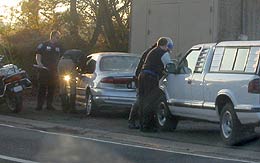
On October 8th, 2002, I was pulled over for speeding on a downtown street in Sacramento. It was 8pm and I was zooming south on 12th street where it enters downtown from highway 160. As I crossed C Street, I spotted two motorcycle cops waiting at the intersection, watching me cruise by. My theory and behavior has changed in the last few years: When I was caught speeding in the past, I used to continue at the same rate of speed, not wanting to show my brake lights for fear that I would be "admitting wrongdoing" by slowing down. Sometime around 4 years ago I changed tactics, deciding that it was better to react to the presence of a police officer than it was to ignore (or appear to ignore) him or her. What I am trying to say is that when I saw the cops, I hit the brakes, which had the unfortunate effect of making an ERT! ERT! skidding noise as I crossed in front of them. |
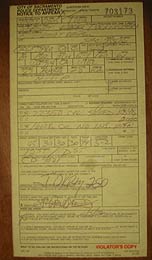 Well
Damn. One policeman behind me on a motorcycle. Well
Damn. One policeman behind me on a motorcycle.
Red lights on and I pulled onto a side street and shut the car off. He came up to the window and asked for my license and registration. I handed them over and asked him if he was writing me up for the speeding or for the skidding. "The speeding", he answered. I got a ticket for 22350 (basic speed law) and for 16028A (proof of insurance required). I have insurance, but I didn't have the appropriate papers in the car to prove it. I had my Triple A card, but it was the plastic auto club card, not the square of paper that proves I have insurance with them. The ticket had little squares for speed approx., pr/max spd, veh. lmt, safe, and radar. The officer filled it out showing I was traveling about 45mph in a 30mph pr/max spd, veh. lmt, safe zone. This was backed up by a 44mph radar reading. A speeding ticket is a notice to appear in court. When you sign the bottom, you are promising to appear in court on or before the date and time shown. I signed the bottom and Voila! I had a court date. |
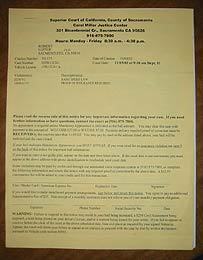 The court date was November 5th, so I marked my calendar. Missing court
dates is worse than missing flights.
The court date was November 5th, so I marked my calendar. Missing court
dates is worse than missing flights.
In the hours and days after I got the ticket, I fretted and grumbled about getting caught speeding. My thoughts went like this: Why had I chosen that way home?..Why was I going so fast?..Wasn't it better for everyone if I traveled quickly, so long as I didn't hit anyone?.. I don't think there was even a speed limit posted on that street...30 is ridiculous. That street is like a four-lane highway..etc. Before my court date arrived, I got a notice in the mail from the Superior Court of California. This notice confirmed my court date and told me about how nasty things could get if I didn't go. It also indicated that I could avoid going to court by paying a fine. There were two fines outlined. If I proved that I had had insurance at the time I got the ticket, the fine would be $97. If I could not prove that I had had insurance, the fine would be $627. Furthermore, I could pay by credit card, but there was a $12.95 convenience fee for that. I could also make installment payments if I agreed to a $35 administrative fee. The notice also explained that if I didn't have insurance when I got the ticket, but I went out and got some, that fine would be reduced from $530 to $281. |
|
I remembered reading somewhere that California's Basic Speed law was remarkably flexible when it came to driving below 55 miles per hour, so I did some research online. Basic Speed Law 22350 No person shall drive a vehicle upon a highway at a speed greater than is reasonable or prudent having due regard for weather, visibility, the traffic on, and the surface and width of, the highway, and in no event at a speed which endangers the safety of persons or property. I could have paid the ticket with a $97 check that day and forgotten about it, but by going to court, I had a chance to have that amount reduced. Based upon my suspicions that I could beat this ticket, and that I could write an interesting story about it, I decided to take it to trial.
The Infraction Arraignment I sat in the smallish courtroom, in the audience area. There were about 90 seats with about 30 people in them. This was the 9:30am group, and right on time, a video started playing on the two monitors. The video explained what was going to happen in the arraignment. We could:
Before the video was over, the bailiff, a police officer in the courtroom, turned it off. He explained that the end of the video was kind of a waste of time, and that he knew we all wanted to get out of there as quickly as possible. He also warned us against talking while court was in session. Then he asked us to please rise while Commissioner Red Thomspon (not his real name), entered. The commissioner gave us the same information as the video: He was going to call our names one at a time and we would stand at the wooden podium and plead. Before he got started with the list of names, however, he would allow anyone who wanted to just plead guilty, pay the fine and get out of there to do so right from the top. This was the second time that I had the option to save time by paying the fine. This option was given a few more times. Being in court was like gambling with your time. I was gambling that if I risked my time here in court, I would not have to pay the $97. A few people immediately stood up and waited in line to speak at the podium. You can see the podium in the above photo just under the white California flag. They said their name, the Commissioner read their violation from his sheet, and they plead guilty. Some asked for a chance to go to traffic school.
The next case was a seven year-old kid caught without a bicycle helmet. His father was there too. He pled guilty and the judge let him off with a warning. Next was an illegal turn for $114. The next guy didn't have insurance at the time of his traffic stop, but had since obtained insurance. He was ordered to pay $280. The next guy needed an interpreter of some kind, so he had to reschedule when an interpreter could be found. The next guy in the line was accused of not having insurance, but he didn't want to plead guilty. The judge told him to sit down. "If you want to make some comment, have a seat. If you want to plead guilty, we will do it now, but if you want to say something, or... make some comment, have a seat and wait with everyone else". The next woman had disobeyed a sign, $114, and finally a guy ran a stop sign and was told to pay $171. Most of the above people had asked for the chance to go to traffic school. Signing up for traffic school does not lower your fine, in fact it increases the fine by $30 and then costs an additional ~$40 and the investment of a day. Traffic school is a desirable option because it will keep the violation off of your driving record. More about traffic school in California. After the guilty-pleaders were finished, the commissioner began calling names. One at a time the accused stood and had their violations read to them. About half had some excuse or concern, but were pleading guilty. The other half were pleading not guilty. When it was my turn I pled not guilty and like those before me was told to speak to an assistant District attorney in the corridor next to the courtroom. In the corridor, I was immediately met by a man about my age. He reminded me that I could have a trial if I wished, but offered me a deal: If I pled guilty, he would reduce the fine to $65, but I wouldn't be eligible for traffic school. I told him I was leaning towards a trial. |
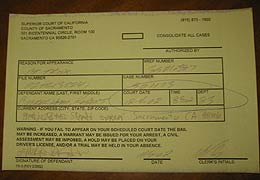
"Are you leaning towards a trial, or are you sure you want to go to trial?" he asked. "I want to go to trial", I answered. He motioned me back to a seat in the front of the courtroom. In a few minutes I had set a court date for December 4th at 8:30am. They gave me a little yellow note. Traffic court likes yellow paperwork. I left. |
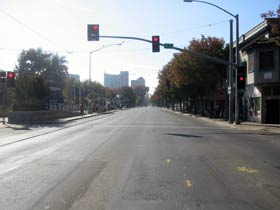 Immediately, I drove
down to the scene of the crime, I mean citation:
12th Street and D. Immediately, I drove
down to the scene of the crime, I mean citation:
12th Street and D.
I thought that if I could describe my driving as safe, I could put doubt in the judge's mind and win the case. 12th Street is a four-lane one-way artery into the heart of downtown Sacramento. A flat, dry street like that seemed like it had all the finer qualities of a freeway... except for, you know, the sidewalks and stop lights. The top of 12th street is a seedy area. Outside one market young men loitered, looking like herb salesmen. I started to think that the police officers had been there to shoo dealers, not catch speeders. I walked along the street and looked for the 30 mph speed limit sign. I couldn't find one! I walked up the street 4 blocks and came back empty-cameraed. There was no speed limit sign! I took a photo of the road to help illustrate the width (and safety) of a four lane road and got back into my car. I circled around and drove back down 12th, re-enacting the offending travel. I kept my eyes peeled for a speed limit sign and this time I spotted it. Speed Limit 30, plain as day. Drat! |
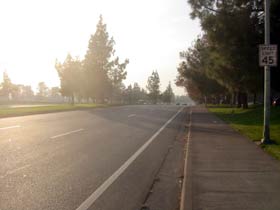
I was nervous about my court date. I think anyone would be. When people talk about going to court on speeding tickets, they always mention that if the ticketing officer doesn't show up for the trial, your case is dismissed. I was hoping for this, but I wasn't counting on it. I didn't want to wasting the court's time when I was on the hot seat. I wanted to be prepared to offer some proof of innocence or defense of my actions. I didn't find it that day, but in the next few days I noticed streets similar to 16th marked with higher speed limits. One was on Exposition Blvd, pictured here, where three lanes travel in each direction and the limit is posted at 45 mph. I decided this would be my high-speed comparison to Sixteenth Street. How could 16th be unsafe at 45mph while Exposition was not? Expo is only three lanes wide, with sidewalks on one side. It passed by a hospital and a children's water park. I printed photos of both streets to present as evidence. I could have photoshopped in a little broken glass and some skulls, but that could get me in trouble. Over Thanksgiving, I bragged to my father about how clever I was to have scheduled an early morning trial after getting a ticket in the evening. I figured I was decreasing the chances of my ticketing officer showing up if he would have to wake up early to attend. Dad dispelled that notion, "he'll get paid overtime". |
 On
December 4th I was back at the Carol Miller Justice Center. This should
not be confused with the "Hall of Justice", which is where the
Superfriends operate. On
December 4th I was back at the Carol Miller Justice Center. This should
not be confused with the "Hall of Justice", which is where the
Superfriends operate.
Before the trial I sat in the hallway with two of my fellow defendants. One, an Indian-American guy, was accused of traveling in a carpool lane freeway onramp. He explained that with his large truck, it could be difficult to merge safely, so he used the carpool lane and got busted. His ticket was for $275. Inside the courtroom, there were four other defendants and one police officer. Again a video played and explained what would happen in this court. First, the ticketing officer would give his version of what happened. Then it was the defendant's turn to question the officer. After asking the officer questions, the defendant could then state his side of the story. Next, the officer is given a chance to refute that information, then it goes back to the defendant. I guess it could go back and forth quite a few times. No one had lawyers and there is no jury. When they are done talking the judge is the one who decides the case. By the time the video was over, more cops and defendants had arrived. Some of the officers wore suits, and some wore their uniform. |
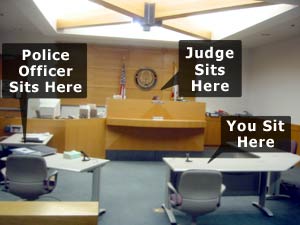
The Judge, Commissioner Phillip Stanger called roll. There were eleven cases, seven defendants and four cops. When he got to my case, my ticketing officer did not respond, so I breathed a sigh of relief, but I wasn't free yet. Cases with both a police officer and a defendant began. The first case involved a woman running a stop sign and speeding. The ticketing officer began (This isn't an exact quote), "My name is Sergeant Smith, I am a five-year veteran of the California Highway Patrol. On October 8th, at 2:40pm while on patrol in the Arden Area, I observed a Ford van approach the intersection of Trixie and Spridle at a high rate of speed. The posted speed limit on Trixie is 35 mph and I estimated the speed of Ms. Rabbit at 49. My estimates were confirmed by radar. Her vehicle slowed as it approached the stop sign, but did not come to a complete stop. I proceeded to make a vehicle stop at that time and issued a citation to Ms. Rabbit for failure to obey a stop sign. She became very irate and began calling me names despite the fact that she had a van full of kids.". Now it was Ms. Rabbit's turn to ask the policeman questions. She didn't appear to have any questions, but she looked really pissed off. She stated her side of the story poorly, particularly when compared to the comprehensive and rational description that the officer gave. Her position was that she would not have had time to accelerate to 49 mph on the short distance between Asmont and Spridle. She also objected to being called irate. When she was finished it was the officer's turn to respond. He had nothing to add so the judge made a decision. Ms. Rabbit was found guilty and he ordered her to pay a $114 fine. She then became irate, standing and holding out her arms. "What?! That's it? He wins?" She squinted her eyes and pointed at the police officer, saying something under her breath. The judge then warned her that if she didn't compose herself, he would have the bailiff remove her.
|
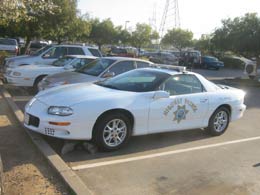 The next two cases went pretty much the same way, with the police
officer's story sounding complete and the defendant sounding unprepared
and clutching for straws.
The next two cases went pretty much the same way, with the police
officer's story sounding complete and the defendant sounding unprepared
and clutching for straws.
First a man who had been caught alone in the carpool lane (guilty, $281), then a guy caught speeding on Freeport Blvd.(guilty, $173). Next it was my my turn. I sat down where the other defendants had sat and the judge addressed me directly, "Mr. Cockerham, it is 9:15am and your ticketing officer has not appeared. Your case is dismissed. You are free to go." "Whoo hoo!", I thought to myself. For a moment, I considered waiting to see what happened in the rest of the cases, but quickly regained my senses and got out of there. Close on my heels was my Indian carpool-lane friend. His officer hadn't shown up either, saving him $275. We gave each other a high-five, smiling and pumping our fists. "I scheduled my trial for early in the morning", he bragged, "because I knew my officer worked in the night time!" I laughed, "Me too!" To celebrate victory, I enjoyed a big bottle of champagne on the way
home. |
| I don't know how my trial would have turned out
if my ticketing officer had appeared that day. Maybe I would have lost,
maybe I would have won. I was very happy to get the whole thing over with,
particularly since it saved me $97. Being unemployed during this process
made it easy to risk time and energy in my defense, plus I could risk
getting a mark on my driving record.
Courtroom Summary: The arraignment judge did not lower anyone's fine for simply showing up in person (except for the bicycle helmet kid), so you might as well just send the money if you are going to plead guilty anyway. If you want a lower fine, you are going to have to fight for it by refusing guilt until the DA offers you a smaller fine. If you feel you aren't guilty, read the law you are accused of breaking and prepare a case. I don't know for sure, but I believe an officer is less likely to show up if he thinks you could win and more likely to show up if you were a nitwit when he pulled you over. Good luck. This information is based upon my very limited experience in traffic court. I am not a lawyer. The blue flow chart above is based on my own choices in my particular case and may not reflect the choices you are given. I couldn't figure out the difference between a commissioner and a judge, but I think it is the same thing. Please use your turn signal. It helps other people figure out what you are doing. |
Other Easy, Illustrated How-to Instructions from Cockeyed.com | Cash4Gold will offer one-third of the value of your gold
Cockeyed How to Guides :
How to Get a Ticket to a Sold-Out Show |
How to Make a Sign
How to Memorize the Geography of Africa |
How to Memorize the Geography of Canada |
How to Remove Shoes from Telephone Lines |
How Not to Build a Patio Cover |
How to Remove Slats From Blinds |
How to Remove a Toilet Ring |
Things I Figured Out, Part 3 |
Fence Ideas |
Easy, Illustrated Instructions on How to Fix a Fence |
How Fences Break |
How to Fix a Gate |
How to Keep your Video Card Cool |
How to Patch a Hole in the Wall |
How to Paint a Room |
how to make a mold out of silicone caulk |
how to have a halloween costume contest |
How to Siphon Liquids |
How to Unlock the Bathroom Door |
How to Repair the Lens Mechanism |
How to Reset a Circuit Breaker |
Using the Hell out of your Digital Camera |
How to Decorate your House with Christmas Lights |
How to paper mache |
What is the Learning Curve? |
How to change a flat tire |
how to make coffee |
How to change your brake pads |
How to Replace the Pull Cord on your Lawnmower or Leaf Blower Engine |
How to Cut and Paste |
How to make fire with two sticks |
Refilling an Ink Cartridge |
How to Fight a Speeding Ticket in court |
contact Rob | science club | pranks |
How much is inside? |
Home |
Incredible Stuff I Made | Torn-up
Credit Card Application
February 15th, 2009